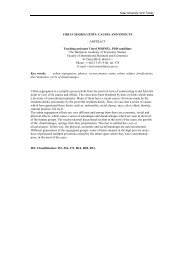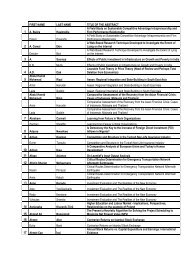Indre Jucaityte
Indre Jucaityte
Indre Jucaityte
You also want an ePaper? Increase the reach of your titles
YUMPU automatically turns print PDFs into web optimized ePapers that Google loves.
4<br />
• What is the relationship we have in common? (relations with the brand)<br />
Brand value can not be built until its identity is established. Favorable response is<br />
possible only when the appropriate value is created. The relations can not be built until<br />
the appropriate reaction is elicited. In order to build strong relationships the sense<br />
dimensions can be of the great help. Senses can help to create a brand that would be<br />
recognized by more and more customers. Consequently the brand will be stronger and<br />
more valuable.<br />
2.3. Senese aspect in creation of brand value<br />
According to Kotler and Keller (2007), in order to distinguish the brand from its<br />
competitors, it’s important to give him additional value. The main benefits of the brand<br />
are awareness and confidence for the consumer that he buys constant quality products that<br />
can satisfy his needs (Chernatony, 2001).<br />
The majority of marketing professionals are working in the two-dimensional world and<br />
only sometimes they dare to enter into a wider universe, in which they exploit all five<br />
senses (images, sound, hearing, taste, touch). These five senses and their importance to<br />
brand value creation process are emphasized by the concept of marketing of senses.<br />
These marketing issues are analyzed by Lindstrom (2008), Valenti, Riviere (2008),<br />
Rieunier (2002) and others. Marketing of senses is a business concept, which has received<br />
attention only a few decades ago.<br />
Kotler (1973) acknowledged the progress of business thought and also found that<br />
consumers perceive the purchase decision more than just acquisition of a product or<br />
service. He also presented the product concept and definition of the atmosphere,<br />
indicating that the packaging, advertising, warranties, service, financing, courtesy,<br />
images, as well as the location of the products in the stage from buying to the<br />
consumption is of the critical importance. He argues that the environment around the<br />
product, in some cases is almost of the same importance as the main product. Many other<br />
scientists (Bitner (1986), Donovan, Rossiter, Marcoolyn and Nesdale (1994), Chebat and<br />
Michon (2003)) also state that environment around the product is important, because it is<br />
a marketing tool with the help of which the client's feelings are stimulated.<br />
Marketing of senses is defined as the number of actions controlled by the manufacturer<br />
and / or seller, in order to achieve a specific product or service environment within the<br />
same product or through another means of communication. Other authors marketing of<br />
senses defined as “marketing approach by the stimulation of procurement and making<br />
relations between the brand and its customers thanks to the five senses as part of the<br />
stimulating action of products, distribution and communication”.<br />
Thus, to some extent, it can be argued that marketing of senses tries to fill gaps in<br />
traditional marketing, focusing on rational elements of the product and services. Solomon




